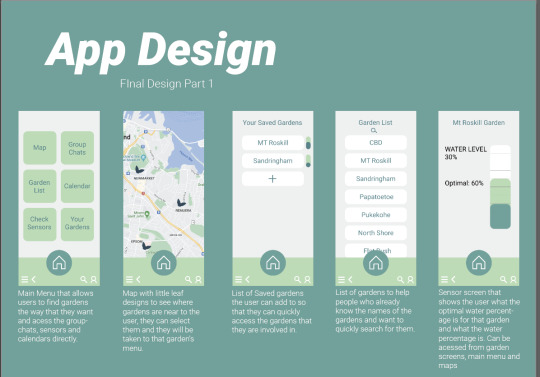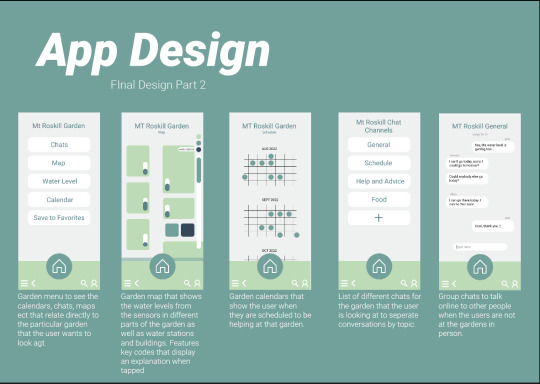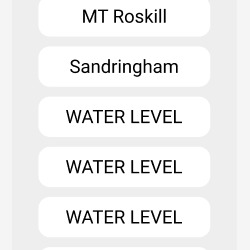Text
Updated References:
Andreas Wesener. (2020). Urban Resiliance in a global context. Growing Resiliant Cities. 77-100
Carlson, T., Moewaka Barnes, H., Reid, S., & McCreanor, T. (2016). Whanaungatanga: A space to be ourselves. Journal of Indigenous Wellbeing, 1(2), 44-59.
Gustav Chu-Ling. (February 2022). Food insecurity and the community aspect of food,
Hond, R., Ratima, M., & Edwards, W. (2019). The role of Māori community gardens in health promotion: a land-based community development response by Tangata Whenua,
people of their land. Global Health Promotion, 26(3_suppl), 44–53. https://doi.org/10.1177/1757975919831603
Joseph Giacomin. (2014) What Is Human Centred Design?, The Design Journal, 17:4, 606-623, DOI: 10.2752/175630614X14056185480186
Luke Scheberl, Bryant C. Scharenbroch, Les P. Werner, Jacob R. Prater, Kelby L. Fite, . (2019). Evaluation of soil pH and soil moisture with different field sensors: Case study
urban soil. Urban Forestry & Urban Greening Volume 38, 2019, Pages 267-279, ISSN 1618-8667. https://doi.org/10.1016/j.ufug.2019.01.001.
Maori Dictionary. (2022). Whanaungatanga. Maori Dictionary: https://maoridictionary.co.nz/word/10068
McNatty, W., & Roa, T. (2002). Whanaungatanga: An illustration of the importance of cultural context. He Puna Korero: Journal of Maori and Pacific Development, 3(1), 88-96
Meter Environments. (n.d). MEASUREMENT VOLUME OF METER VOLUMETRIC WATER CONTENT SENSORS. 5
Modibedi, T.P., Masekoameng, M.R. & Maake, M.M.S. The contribution of urban community gardens to food availability in Emfuleni Local Municipality, Gauteng Province.
Urban Ecosyst 24, 301–309 (2021). https://doi.org/10.1007/s11252-020-01036-9
O’carroll, A. D. (2013). Virtual Whanaungatanga: Māori utilizing social networking sites to attain and maintain relationships. AlterNative: An International Journal of Indigenous
Peoples, 9(3), 230–245. https://doi.org/10.1177/117718011300900304
Peryea. (2001). Gardening on Lead- and Arsenic-Contaminated Soils. Pullman, Washington: Washington State University. Extension. https://rex.libraries.wsu.edu/esploro/outputs/
report/Gardening-on-Lead--and-Arsenic-Contaminated-Soils/99900501708101842#file-0
Robert C. Reedy and Bridget R. Scanlon. (November 2003). Soil Water Content Monitoring Using Electromagnetic Induction. DOI: 10.1061/(ASCE)
1090-0241(2003)129:11(1028)
University of Otago and Ministry of Health. (2011) .A Focus on Nutrition: Key findings of the 2008/09 New Zealand Adult Nutrition
0 notes
Photo


Added in place markers for the gardens on the city map and created maps of the gardens to show the water levels at the different parts of the garden as well as the layout of each so that people can know in advance, this will help with accessibility for those that need it. There is a pop-out menu for the different colour keys as shown here.
0 notes
Photo
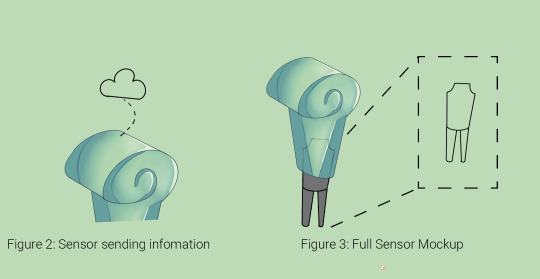
Updated the sensor design to better show how the water volume sensor sits into my design and illustrate it sending the information to the cloud so that it can be accesses in the app.
0 notes
Photo

Now that I knew what pages there would be, I made a main menu that takes the user to the primary places they would want to go.
0 notes
Photo

From more user feedback I added the option of saving gardens you visit regularly to save the user having to search for them every time. I also made it so that in this list the user can see the overall water level of those gardens so that they have a general idea of the situation without having to go into the garden sensor levels.
0 notes
Photo

From User feedback I added in multiple channel options for the text channels so that conversations would be easier to keep track of.
0 notes
Text

Jenny - early 30s and has 1 kid and works full time. She tends to find that she eats unhealthy means as she is busy and does not always have time to find recipes/ food that is health for herself and her kid, she has limited time but would like to join in with the project when she can and learn from other to find out how they eat health as well as access some of the good and healthy food grown in the gardens. This will help her with time, to find information and to network with people who can support her.
User Pathway- She goes to the messaged to talk to people about food and the project she goes to the calendar to see what time-slots she can fill and puts her name down for gardens near her. She checks the location on the calendar.
0 notes
Text
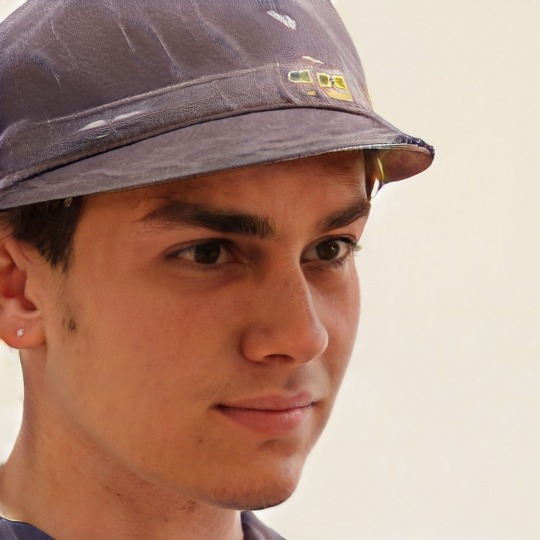
POV 1: Ben - early 20s, struggling with earning money and being able to pay for everything which has lead to them struggling to afford healthy food and so they want to find a way to have access to good food that they can afford. They also want to meet people because finding people to be friends with is hard in Auckland. And they want to be outside more often for health.
User Pathway- Opens app and finds the main menu - goes to the map to find gardens near them - clicks on one and joins the chat for this garden and starts to talk to people - checks the water level to see how it’s doing - adds themselves into the calendar so that other people know when they are available.
0 notes
Text

A B testing Three- Gave this new version next to the old version of the calendar to a user who said that they preferred this new version because it was cleaner and easier to look at.
0 notes
Text

I began adding in darker backgrounds for a more finished and professional feeling to the application
0 notes
Text

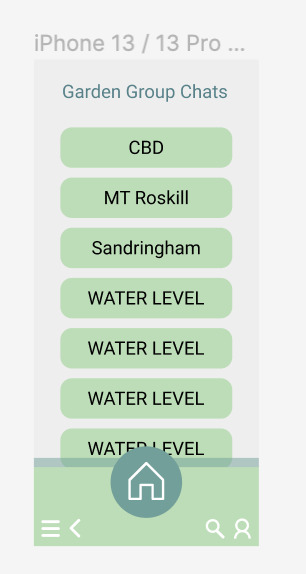
AB Testing One- I gave this to some potential users to give feedback on and they decided that the white backgrounds were more readable and didn’t have too much overwhelming green
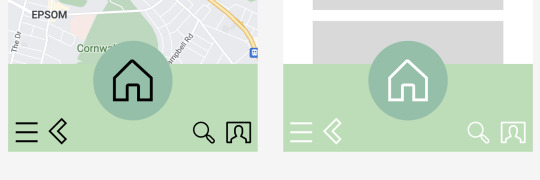
AB testing Two- I also gave these ones to users who thought that the white was a better option because it was lighter and the theme was overall more comfortable for them to look at
0 notes
Text
References
Andreas Wesener. (2020). Urban Resiliance in a global context. Growing Resiliant Cities. 77-100
Carlson, T., Moewaka Barnes, H., Reid, S., & McCreanor, T. (2016). Whanaungatanga: A space to be ourselves. Journal of Indigenous
Wellbeing, 1(2), 44-59.
Gustav Chu-Ling. (February 2022). Food insecurity and the community aspect of food,
Hond, R., Ratima, M., & Edwards, W. (2019). The role of Māori community gardens in health promotion: a land-based community
development response by Tangata Whenua, people of their land. Global Health Promotion, 26(3_suppl), 44–53. https://-
doi.org/10.1177/1757975919831603
Joseph Giacomin. (2014) What Is Human Centred Design?, The Design Journal, 17:4, 606-623, DOI:
10.2752/175630614X14056185480186
Maori Dictionary. (2022). Whanaungatanga. Maori Dictionary: https://maoridictionary.co.nz/word/10068
McNatty, W., & Roa, T. (2002). Whanaungatanga: An illustration of the importance of cultural context. He Puna Korero: Journal of
Maori and Pacific Development, 3(1), 88-96
Meter Environments. (n.d). MEASUREMENT VOLUME OF METER VOLUMETRIC WATER CONTENT SENSORS. 5
Modibedi, T.P., Masekoameng, M.R. & Maake, M.M.S. The contribution of urban community gardens to food availability in Emfuleni
Local Municipality, Gauteng Province. Urban Ecosyst 24, 301–309 (2021). https://doi.org/10.1007/s11252-020-01036-9
O’carroll, A. D. (2013). Virtual Whanaungatanga: Māori utilizing social networking sites to attain and maintain relationships. AlterNative:
An International Journal of Indigenous Peoples, 9(3), 230–245. https://doi.org/10.1177/117718011300900304
Robert C. Reedy and Bridget R. Scanlon. (November 2003). Soil Water Content Monitoring Using Electromagnetic Induction. DOI:
10.1061/(ASCE)1090-0241(2003)129:11(1028)
University of Otago and Ministry of Health. (2011) .A Focus on Nutrition: Key findings of the 2008/09 New Zealand Adult Nutrition
0 notes
Text
Conclusion
I learnt through this project to focus more time into my research and to think more about
what my user would want and need. It is easy as a designer to think of the best solution
to a problem and to neglect what the user might want and find most useful. Through
looking at human centred design I was able to consider that my users are people with
their own perspectives and cultures and behaviours, and these things are not a hinderance
to my designs but an asset. Through this project I have gained an understanding of
how old practises can inform new ones. If something has been being done for a long
time, there is likely a reason as to why this is so useful and so it is good to let these practises
inform the designs we make today. I also learnt to take older ideas and merge them
with new ones, I took the older idea of face-to-face community building and merged it
with the newer idea of online communities. This meant that I was able to take the benefits
of the face-to-face communication and supplement it with online communication to
allow communities not to be lost in the fast pace of modern life.
I will take forward from this project a new appreciation for understand culture and how
old practices can be used to inform new ones.
For the continuation of this project, I will continue to reflect on the research I have done
so far and use it to make the sensor and app designs more complete.
0 notes
Text
I started this project out with my research question; How can design and technology be
used to help lessen the effects of food inequity caused by food shortages and supply
chain issues as a result of covid 19 so that New Zealanders can afford to feed themselves
and their families? I also started with the goal of wanting to help people to access
food in a way that also helped to build and bring together communities. I used a human
centred design method and so I wanted to focus on already existing behaviours and cultures,
which is why I based my project around the idea of Whanaungatanga, which is an
existing communality structure and concept and I used this to help inform my design by
considering how I could use this idea of community and bringing people together through
a shared goal to create something that can help the community provide food for itself for
a long time and through potential future hardship.
I looked at the way that community gardens in Aotearoa have in the past helped to bring
people together and provide access to food, especially after disasters.
This is why my proposal is to have a series of community run gardens around the country
that will be volunteer operated and community funded. These gardens will not only
grow food, but they will grow healthy food and all the food that is grown in them will be
distributed around the community to ensure that those who need it most have access to
good and healthy food.
0 notes
Text
For my methodology I focused on Human Centred Design.
This methodology considers the user and their wants, needs, culture and behaviours to
create a design solution that works for them rather than creating something that they will
need to learn. It proposes that humans already have a set behaviour and that catering
your designs to this will be more beneficial than creating a solution and expecting the
user to learn new behaviours in order to learn how to benefit from the design that you
have created. (Joseph Giacomin. 2014).
I implemented this by researching the issue and how it effects people so that I could understand
how this issue related to people in order to better design a solution for them.
I then also researched Māori culture in Aotearoa so that I could understand how the issue
effects different cultures in Aotearoa. This meant that I understood the relationship between
the problem and the people in effects so that I could create a solution that really
benefits the people that are suffering as a result of this problem.
Human centred design has meant that this project is much more likely to be able to solve
for the user’s need as it understands how they behave and can create a design that fits
into the already established culture in Aotearoa that it is trying to help.
0 notes
